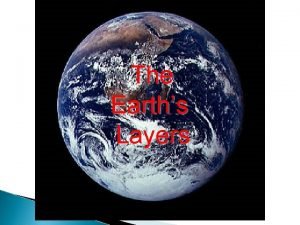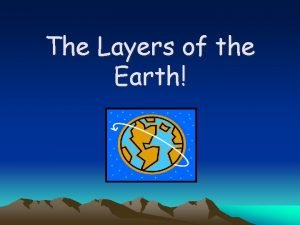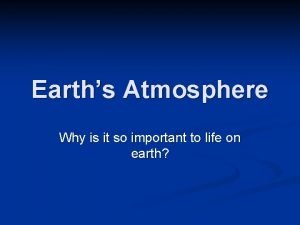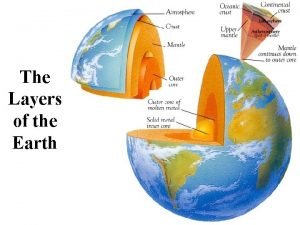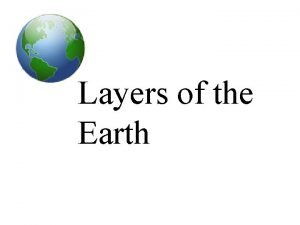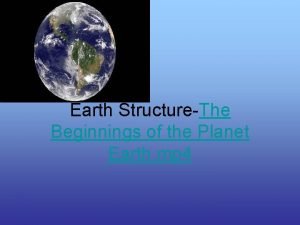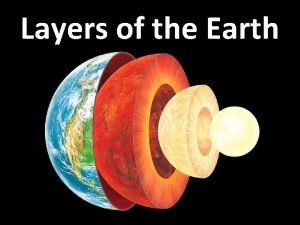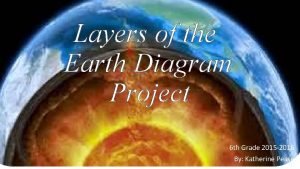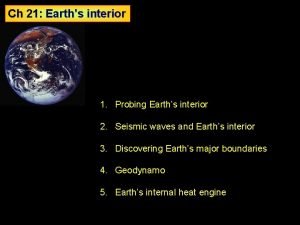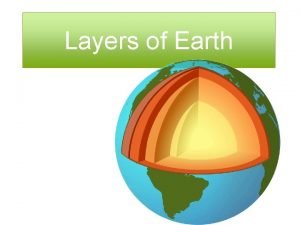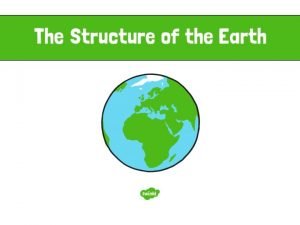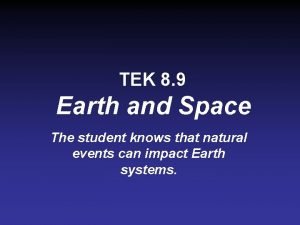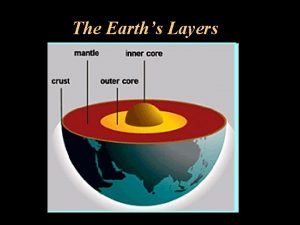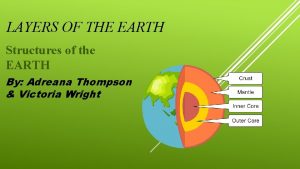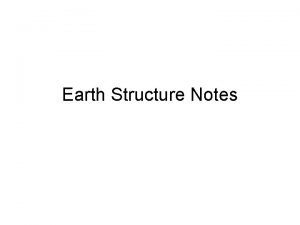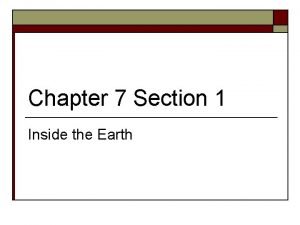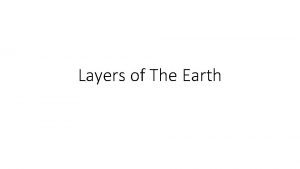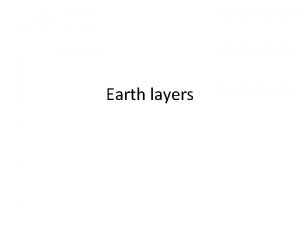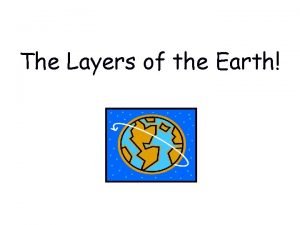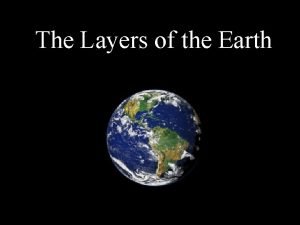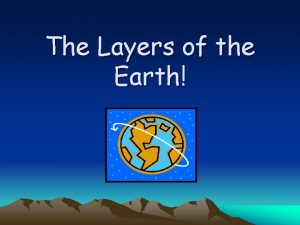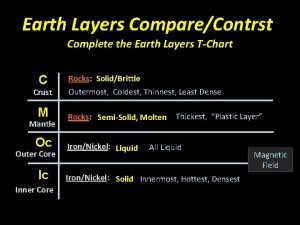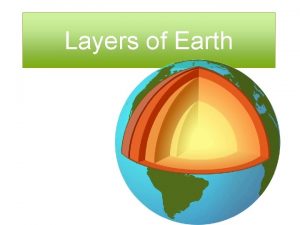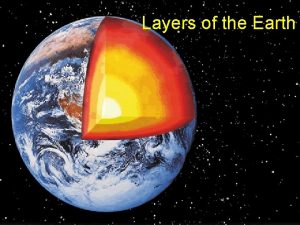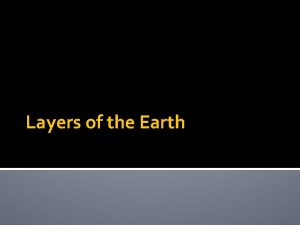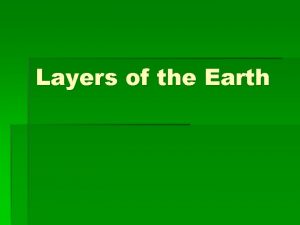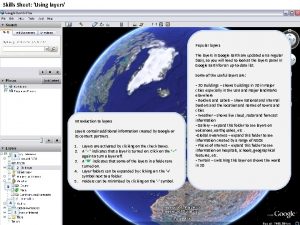Layers of the Earth The Layers of the























- Slides: 23

Layers of the Earth

The Layers of the Earth © Copyright 2006. M. J. Krech. All rights reserved.

The Four Layers The Earth is composed of four different layers. • The crust is the layer that you live on, and it is the most widely studied and understood. • The mantle is much hotter and has the ability to flow. • The outer core and inner core are very hot and have a great amount of pressure. Pressures so great you would be squeezed into a ball smaller than a marble if you were able to go to the center of the Earth!

The Crust The Earth's Crust is like the skin of an apple. It is very thin in comparison to the other three layers. The crust is only about 3 -5 miles (8 kilometers) thick under the oceans (oceanic crust) and about 25 miles (32 kilometers) thick under the continents (continental crust). The crust is composed of two rocks. The continental crust is mostly granite. The oceanic crust is basalt. Basalt is much denser than the granite. Because of this the less dense continents rises to the top and denser oceanic plates sinks to the bottom.

The Lithosphere The crust and the upper layer of the mantle together make up a zone of rigid, brittle rock called the Lithosphere.

The Lithospheric Plates The crust of the Earth is broken into many pieces called plates. The plates "float" on the soft, semi-rigid asthenosphere.

The Asthenosphere The asthenosphere is the semi-rigid part of the middle mantle that flows like hot asphalt under a heavy weight.

The Mantle is the largest layer of the Earth at 2900 km thick. The movement of the middle mantle (asthenosphere) is the reason that the crustal plates of the Earth move.

Convection Currents The middle mantle "flows" because of convection currents. Convection currents are caused by the very hot material at the deepest part of the mantle rising, then cooling and sinking again --repeating this cycle over and over.

The Outer Core The core of the Earth is like a ball of very hot metals. The outer core is so hot that the metals in it are all in the liquid state. The outer core is composed of the melted metals of nickel and iron.

The Inner Core The inner core of the Earth has high temperatures and pressures so great the metals are squeezed together and are not able to move about like a liquid, but are forced to vibrate in place like a solid.

Earth Layers Foldable Notes - Write underlined information in each flap of the foldable.

• How far have scientists drilled into the earth? • 7. 6 miles – Only 0. 2% of the distance to the earth’s core

How do we know so much about what’s under Earth’s surface? • Through INDIRECT EVIDENCE, mostly from seismic waves caused by earthquakes (more on this later this semester. . . ) • Sometimes indirect evidence is the only option for scientists to develop a theory • Lets give it a try. . .

So. . . here’s what scientists know. . . • Please add the following notes to the layers of the Earth foldable. • It is suggested that you write down the underlined notes

Earth’s 4 main Layers (Define each layer) • • Crust Mantle Outer Core Inner Core

The Crust • The crust, the outermost layer, is rigid and very thin • Oceanic Crust (beneath the ocean) is about 5 km thick • Continental Crust (under land) averages about 30 km and 100 km deep. • Like the shell of a hardboiled egg

The Lithosphere (write under crust flap) • Lithosphere= the crust and the uppermost part of mantle

The Mantle and Asthenosphere • Asthenosphere= the fluid like portion of the mantle that lies just below lithosphere. The lithosphere “floats” on the asthenosphere • The mantle contains more iron, magnesium, and calcium than the crust

Convection Currents (write under mantle flap) The middle mantle "flows" because of convection currents. Convection currents are caused by the very hot material at the deepest part of the mantle rising, then cooling and sinking again --repeating this cycle over and over.

The Outer Core • The core of the Earth is like a ball of very hot metals. The outer core is so hot that the metals in it are all in the liquid state. The outer core is composed of the melted metals of nickel and iron. • As the Earth rotates, the liquid outer core spins, creating the Earth's magnetic field.

The Inner Core The inner core of the Earth has temperatures and pressures so great the metals are squeezed together and are not able to move about like a liquid, but are forced to vibrate in place like a solid.

Practice Quiz Question • Can you label the following layers?
 Structural layers of earth
Structural layers of earth How many layers are there in the earth
How many layers are there in the earth Types of atmosphere
Types of atmosphere Layers of the earth
Layers of the earth Layers of the earth
Layers of the earth The layers of earth from most dense to least dense
The layers of earth from most dense to least dense Plate tectonics jeopardy
Plate tectonics jeopardy What are the 3 layers of the earth
What are the 3 layers of the earth Layers of the earth diagram
Layers of the earth diagram Mechanical layers of the earth
Mechanical layers of the earth Earth asthenosphere
Earth asthenosphere Lithosphere
Lithosphere Five layers of the earth
Five layers of the earth Basic layers of the earth
Basic layers of the earth Earths layer foldable
Earths layer foldable Horizontal boundary
Horizontal boundary Thickest layer of the earth
Thickest layer of the earth Foldable layers of the earth
Foldable layers of the earth Crust and mantle rap
Crust and mantle rap Illustration of layers of the earth
Illustration of layers of the earth Layers of earth
Layers of earth Layers of the earth convection currents
Layers of the earth convection currents Chapter 7 section 1 inside the earth answer key
Chapter 7 section 1 inside the earth answer key What is the thickest crust
What is the thickest crust
